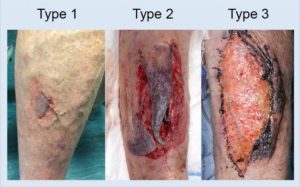Skin lacerations
Download and print as a PDF
DownloadPlease be aware that there are images of wounds on this page
- What is a skin laceration?
- What can cause a skin laceration?
- Who gets skin lacerations?
- What does a skin laceration look like?
- How will my skin laceration be treated?
- How long will my wound take to heal?
- What can I do to help my skin laceration heal?
- What can I do to help prevent a skin laceration from happening?
- Who can I contact for further information or advice?
What is a skin laceration?
A skin laceration, also known as skin tear, is a type of wound where the top layer of skin (epidermis) becomes separated from the deeper skin layers (dermis). Occasionally both layers will separate causing a deeper wound.
What can cause a skin laceration?
- Friction and shearing forces (rubbing together of the layers of skin).
- Trauma to your skin caused by a sharp object or by impact injury from a blunt object or force.
Who gets skin lacerations?
Although anyone can get a skin laceration some groups of people are at higher risk:
- Frail older people with thinning skin.
- People with very dry and fragile skin.
- People who have been treated for a long time with a high doses of steroids (medication that thin the skin making it vulnerable to damage).
- People with poor nutrition and/or hydration which can cause the skin to break down more easily.
What does a skin laceration look like?
Skin lacerations can vary in appearance depending on their size, depth and amount of skin that is lost. There is likely to be bleeding and some underlying structures such as fat, muscle or connective tissue may also be visible.

Skin lacerations
- Type 1: Minimal or no skin loss. Skin can be fully replaced over wound bed.
- Type 2: Partial skin loss. Some skin can be replaced over the wound bed.
- Type 3: Total skin loss. No skin available for replacement.
How will my skin laceration be treated?
The main aim of the treatment is to ‘save’ as much of the damaged skin as possible and protect the surrounding skin. The clinician will try to bring the edges of the wound together as much as they can. This skin will then be secured with a dressing. The limb will be supported by dressings (i.e bandaging). The wound will then be left undisturbed for between two to seven days.
How long will my wound take to heal?
Varying factors influence healing time, and for this reason it is difficult to offer a time frame. Age, smoking, blood supply, diet, medical conditions, size and depth of wound all play a part in healing length. Each person and wound is different and is assessed and treated based on individualised wound assessments.
What can I do to help my skin laceration heal?
- Keep the dressing dry and clean and away from areas where pet hair is present.
- Eat a balanced healthy diet with plenty of protein (see eating to heal leaflet for further information).
- Elevate the limb to reduce swelling and improve venous return.
- Attend all given medical appointments and follow medical advice given (e.g showering wound when appropriate).
- Regular dressing changes help to reduce the chances of infection, maintain the health of the surrounding skin and ensure the appropriate dressings are used on a continuously changing wound bed.
What can I do to help prevent a skin laceration from happening?
- Look after your skin
- Regular cleansing of skin
- Avoid the use of soap which can dry your skin too much. Rinse it off well.
- Use pH friendly soap (e.g Sanex, Nivea, E45).
- Pat skin dry, rather than rubbing.
- Apply creams and lotions to moisturise and rehydrate skin.
- Eat a healthy balanced diet and drink plenty of water to stay hydrated.
- Observe your skin and report any concerns to a health care professional.
- Wearing long trousers rather than shorts or skirts also offers an additional layer of protection against lacerations.
Who can I contact for further information or advice?
For further information and advice please email the Plastic Surgery team: uhsussex.plasticsteam@nhs.net
This information is intended for patients receiving care in Brighton & Hove or Haywards Heath.
The information here is for guidance purposes only and is in no way intended to replace professional clinical advice by a qualified practitioner.
Publication Date: May 2021
Review Date: February 2024


